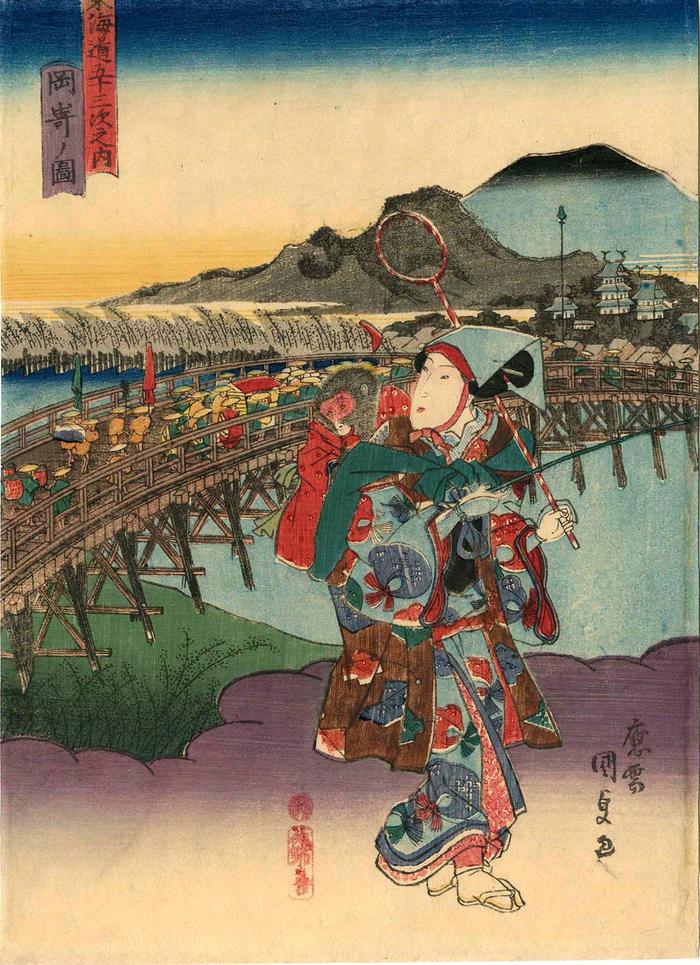Utagawa Kunisada (歌川国貞) / Toyokuni III (三代豊国) (artist 1786 – 01/12/1865)
View of Okazaki (Okazaki no zu: 岡崎ノ図) from the series Fifty-three Stations of the Tōkaidō Road (Tōkaidō gojūsan tsugi no uchi: 東海道五十三次之内)
ca 1838
Signed: ōju Kunisada ga (応需国貞画)
Publisher: Sanoya Kihei
Censor's seal: kiwame
Museum of Fine Arts, Boston
National Diet Library
Spencer Museum of Art
Museum für angewandte Kunst, Vienna
British Museum - Hiroshige's version 'Okazaki Yahagi no hashi'
Virginia Museum of Fine Art
Ishikawa Prefectural Museum of Art - they date their copy to 1836
Bryn Mawr
Honolulu Museum of Art
Fujisawa Ukiyo-e Museum
Victoria and Albert Museum
Nelson-Atkins Museum of Art This is print 39 of this series. This print is very close in its layout to the one created by Hiroshige, with the exception of the female monkey trainer with her monkey on her back.
****
In Hokusai and Hiroshige: Great Japanese Prints from the James A. Michener Collection, Honolulu Academy of Arts on page 202 it says: "The town of Okazaki was the seventh-largest station on the Tōkaidō Road, in terms of its population and the number of houses. It was also the important castle town of Okazaki Castle, where Tokugawa Ieyasu, the first shogun of hte Tokugawa Bakufu, was born."
****
In Tokaido Landscapes: The Path from Hiroshige to Contemporary Artists, 2011, #39, p. 51, speaking of the original Hiroshige print it says in a text by Sasaki Moritoshi: "Seen from the west bank of the Yahagi River with Okazaki Castle on the far bank, the Yahagi Bridge was famous for being the longest on the Tōkaidō. Hiroshige used the entire width of the print to depict the bridge, providing a visual sense of how long the bridge was. The composition resembles Yoshida: there is a town at the far end of the bridge in both prints, as well as processions of daimyos on both bridges and mountains in the distance."
****
The Yahagi Bridge was approximately 1,247' long and stood on 70 pillars.
****
Muneshige Narazaki in Masterworks of Ukiyo-e: Hiroshige, the 53 Stations of the Tōkaidō (p. 69) says: "Here a daimyo procession crosses Yahagi Bridge, the longest on the Tōkaidō. At right is Okazakzi Castle, with Mount Motoyama in the background. The castle no longer exists: on its site there is now a park with a well whose water is said to have been used to wash Ieyasu, the founder of the Tokugawa shogunate, at his birth. Okazaki enters also into the story of Toyotomi Hideyoshi, the sixteenth century military leader who unified Japan, for it was on Yahagi Bridge that he is said to have met Koroku Hachisuka, the robber chieftain who became his first supporter in his triumphant rise to power."
****
Illustrated in a small color reproduction in Kunisada's Tokaido: Riddles in Japanese Woodblock Prints by Andreas Marks, Hotei Publishing, 2013, page 72, T24-39.
Sanoya Kihei (佐野屋喜兵衛) (publisher)
landscape prints (fūkeiga 風景画) (genre)
beautiful woman picture (bijin-ga - 美人画) (genre)
